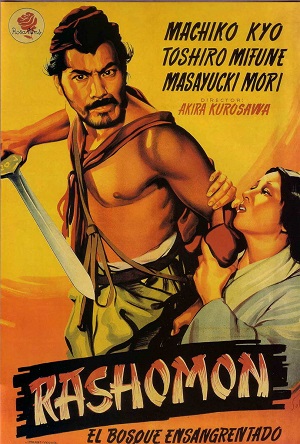Lessons From A 68-Year-Old Classic That Changed The Face Of Visual Storytelling

SOME stories never get old.
I was recently with a group of old friends, recounting a funny incident from 10 years ago. As far as reunion topics go, this was the winning horse — it never fails to bring out the hysterics.
In fact, we realised that the topic somehow became funnier over time.
As I thought about this, and watched the news amid a revived call to ‘Look East’ – a policy first introduced to Malaysians in the 80s – I began wondering about timelessness.
What is it about specific ideas and stories that allow them to endure the test of time?
Amongst all of history’s ground-breaking classics, my mind landed on the memory of watching an old Japanese film for the first time, 16 years ago.
The breakthrough film
In 1950, Rashomon – directed by an era-defining master of cinema, Akira Kurosawa – burst onto the international arthouse stage with its novel camerawork and unique screenplay.
Before its release, few people – including studio executives and crew – could fully understand the depth of its storyline (more on this below). It was a puzzling piece of art, and reviews in Japan were mixed.
But one year later, the film won the highest prize at the prestigious Venice Film Festival (the Golden Lion award), and immediately drew the attention of a post-war, international audience towards Japanese cinema.
Rashomon – as well as Kurosawa’s subsequent work – would go on to influence some of the greatest filmmakers of our time including Werner Herzog, Zhang Yimou, Steven Spielberg, and Martin Scorsese.
You may like: Infographic: 7 Storytelling Structures To Improve Your Presentations
The ‘backstory’
There’s no success sweeter than the one borne of a hard struggle.
The making of this film, in itself, is a powerful story of innovation, courage and individuality — all key ingredients of timelessness.
In his 1981 book, Something like an Autobiography, Kurosawa recalls how three assistant directors assigned to him by the studio had found the script ‘baffling’ even after reading it several times.
“We believe we have read it carefully, and we still don’t understand it at all; that’s why we want you to explain it to us.”
Kurosawa wrote: “I gave them this simple explanation: Human beings are unable to be honest with themselves about themselves. They cannot talk about themselves without embellishing. This script portrays such human beings — the kind who cannot survive without lies to make them feel they are better people than they really are.”
Studio executives were not entirely convinced. It has been said that a top studio boss was so dissatisfied with the final product that he opted to remove his name from the end credits.
But Kurosawa, teaming up with cinematographer Miyagawa Kazuo, persisted with their unconventional techniques in storytelling.
“These days it is not uncommon to point the camera directly at the sun, but at the time
Rashomon was being made it was still one of the taboos of cinematography. It was even thought that the sun’s rays shining directly into your lens would burn the film in your camera. But my cameraman, Miyagawa Kazuo, boldly defied this convention and created superb images,” Kurosawa relates in the book.
The measure of a strong idea comes through knowledge, confidence in your expertise, courage to defy popular belief, and ultimately, standing by the outcome – good or bad.
You may also like: Ola Bola: You’ll Believe In Hope Again
Study of human values
Rashomon’s general premise – adapted from two of Ryunosuke Akutagawa’s short stories – is simple: a samurai is murdered in a forest and his wife, raped.
It opens with three strangers taking shelter from the rain under the Rashomon gate. They discuss what they heard at a courthouse. We then hear testimonies (without ever seeing the judges) from the victim, her attacker (a notorious bandit), the murdered samurai (communicating through a medium), and finally, a woodcutter who claimed to have witnessed the crime.
They speak directly into the camera.
All four flashbacks – which give accurate basic facts but stray wildly in details and motivations – raise questions about the relative nature of truth, deception, guilt and points of view.
These contradictory testimonies become amplified by the film’s refusal to provide a proper ending to the mystery. It gives no concrete answer as to who really killed the samurai. All accounts can be both true and false. It implies that there is no absolute truth.
Now, the audience is free to choose their own truth as well as their own criminal by setting what they have just heard against their own frames of reference.
The viewer is fully empowered to judge the characters and is now a major part of the story.
But to draw a conclusion from a film as allegorically beautiful as Rashomon, one may need to watch it several times — our judgements and decisions may only be as valid as our current state of mind.
Rashomon’s narrative had, at the time, boldly confronted some of the timeless, perennial issues that surround mankind, and Kurosawa’s idea to present it on film could have been read as too far-fetched for his time.
But he went ahead to address the complex human psyche through the cinematic experience, and it worked.
It would be the start of Kurosawa’s lasting influence on world cinema. After a career spanning nearly six decades, he died in 1998 at the age of 88.
His legacy would give birth to modern, non-linear storytelling as we see it today.
A powerful experience endures
Our first experiences tend to shape our defining moments. In Leaderonomics, we study such ‘crucible moments’ in the formation of a leader. They could be good, bad, bittersweet, or even frightening. From these powerful experiences, we derive lessons that drive us from one stage of life to the next.
Through Rashomon, Kurosawa had achieved milestones for himself, the industry and the audience:
- His team offered new technical expertise and the film is credited as one of the first to heavily feature unreliable narrators.
- He opened the door for the Western world to appreciate the richness of Japanese art and culture through its cinema.
- He examined universal values but allowed the audience to apply their own on the characters.
- The film’s critical acclaim brought world attention to his body of work which would include his next – and arguably most influential – magnum opus: Seven Samurai (1954).
And the film? Close to 70 years after its release, Rashomon retains its position as compulsory viewing for storytellers and aspiring filmmakers worldwide.
More filmmakers began using its style of presenting conflicting accounts of the same event (known more widely by the term ‘Rashomon Effect’) – we see traces of it in films such as The Usual Suspects (1995) by Bryan Singer, Memento (2000) by Christopher Nolan and Hero (2002) by Zhang Yimou.
Concluding thoughts
Towards the end of Rashomon, an abandoned baby is seen where the three men are sitting. The situation becomes a duel of morality between two of them.
What one of the men does for the crying infant – against the bleak events of the crime earlier – becomes a symbol of hope in the film.
A timeless idea has universal appeal. It lives within common human traits, from one country to another, and from one generation to the next.
It teaches and inspires, yet releases its power to let us make choices. It triggers fresh perspectives.
Most importantly, an enduring idea gives us a reason to look on the bright side. As the story of Rashomon teaches us, amid all the self-serving biases we may face, there is still a place for goodness in people.
Lydia is the managing editor of Leaderonomics. She loves world cinema, and understands that while good stories deserve to be told, it is often the greatest ones that are re-told.
READ: Diaval: The Little Black Raven With A Big Pure Heart
Box of Chocolates





